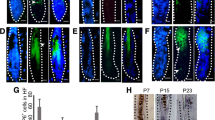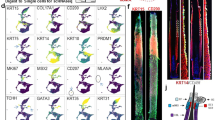Abstract
Involucrin is a structural component of the keratinocyte cornified envelope that is expressed early in the keratinocyte differentiation process. It is a component of the initial envelope scaffolding and considered as a marker for keratinocyte terminal differentiation. The expression pattern of involucrin in human scalp skin and hair follicle cycle stages is not fully explored. This study addresses this issue and tests the hypothesis that “the expression of involucrin undergoes hair follicle cycle-dependent changes”. A total of 50 normal human scalp skin biopsies were examined (healthy females, 51–62 years) using immunofluorescence staining methods and real-time PCR analysis. In each case, 50 hair follicles were analyzed (35, 10 and 5 follicles in anagen, catagen and telogen, respectively). Involucrin was prominently expressed in the human scalp skin and hair follicles, on both gene and protein levels. The protein expression showed hair follicle cycle-associated changes i.e. a very strong expression during early and mature anagen, intermediate to strong expression during catagen and prominent decline in the telogen phase. The expression value of involucrin in both anagen and catagen was statistically significantly higher than that of telogen hair follicles (p < 0.001). This study provides the first morphologic indication that involucrin is differentially expressed in the human scalp skin and hair follicles and reports that involucrin expression pattern undergoes hair cycle-dependent changes. The clinical ramifications of these findings are open for further investigations.




Similar content being viewed by others
Abbreviations
- ABC:
-
Avidin–bioltin complex
- AWS:
-
Average weighted score
- ClH:
-
Club hair
- CTS:
-
Connective tissue sheath
- DP:
-
Dermal papilla
- HCo:
-
Hair cortex
- HF:
-
Hair follicles
- HMC:
-
Hair matrix cells
- HMe:
-
Hair medulla
- HS:
-
Hair shaft
- INF:
-
Infundibulum
- IR:
-
Immunoreactivity
- IRS:
-
Inner root sheath
- IR-score:
-
Immunoreactivity score
- ISTH:
-
Isthmus
- ORS:
-
Outer root sheath
- SG:
-
Sebaceous gland
- TSA:
-
Tyramide signal amplification
References
Adly MA, Assaf H, Nada EA, Soliman M, Hussein MR (2005) Human scalp skin and hair follicles express neurotrophin-3 and its high-affinity receptor tyrosine kinase C, and show hair cycle-dependent alterations in expression. Br J Dermatol 153(3):514–520
Adly MA, Assaf H, Hussein MR (2006) Age-associated decrease of the nerve growth factor protein expression in the human skin: preliminary findings. J Dermatol Sci 42:268–271
Adly MA, Assaf HA, Pertile P et al (2008a) Expression patterns of the glial cell line-derived neurotrophic factor, neurturin, their cognate receptors GFRalpha-1, GFRalpha-2, and a common signal transduction element c-Ret in the human skin hair follicles. J Am Acad Dermatol 58:238–250
Adly MA, Assaf HA, Hussein MR (2008b) Heat shock protein 27 expression in the human testis showing normal and abnormal spermatogenesis. Cell Biol Int 32(10):1247–1255
Adly MA, Assaf H, Hussein MR (2009) Expression pattern of p75 neurotrophin receptor protein in the human scalp skin and hair follicle: hair cycle-dependent expression. J Am Acad Dermatol 42:268–271
Alibardi L (2011) Ultrastructural immunolocalization of involucrin in the medulla and inner root sheath of the human hair. Ann Anat. doi:10.1016/j.aanat.2011.10.012
Balasubramanian S, Efimova T, Eckert RL (2002) Green tea polyphenol stimulates a Ras, MEKK1, MEK3, and p38 cascade to increase activator protein 1 factor-dependent involucrin gene expression in normal human keratinocytes. J Biol Chem 277:1828–1836
Banks-Schlegel S, Green H (1981) Involucrin synthesis and tissue assembly by keratinocytes in natural and cultural human epithelia. J Cell Biol 90:732–737
Christophers E, Kligman AM (1965) Percutaneous absorption in aged skin. In: Montagna W (ed) Advances in the biology of skin, vol 6. Pergmamon, Oxford, p 163
Crish JF, Howard JM, Zaim TM et al (1993) Tissue–specific and differentiation–appropriate expression of the human involucrin gene in transgenic mice: an abnormal epidermal phenotype. Differentiation 53:191
Dawber RPR (1991) Hair follicle structure, keratinisation and the physical properties of hair. In: Rook A, Dawber RPR (eds) Disases of the hair and scalp, 2nd edn. Blackwell Scientific Publications, Oxford, pp 18–50
de Viragh PA, Huber M, Hohl D (1994) Involucrin mRNA is more abundant in human hair follicles than in normal epidermis. J Invest Dermatol 103(6):815–819
Dover R, Watt F (1987) Measurement of the rate of epidermal terminal differentiation: expression of involucrin by S-phase keratinocytes in culture and in psoriatic plaques. J Invest Dermatol 89:349–352
Eckert RL (1989) Structure, function and differentiation of the keratinocyte. Physiol Rev 69:1316
Eckert RL, Green H (1986) Structure and evolution of the human involucrin gene. Cell 46:583–589
Efimova T, Eckert RL (2000) Regulation of human involucrin promoter activity by novel protein kinase C isoforms. J Biol Chem 275:1601–1607
Efimova T, LaCelle P, Welter JF, Eckert RL (1998) Regulation of human involucrin promoter activity by a protein kinase C, Ras, MEKK1, MEK3, p38/RK, AP1 signal transduction pathway. J Biol Chem 273:24387–24395
Enikanolaive A, Lariviere N, Troy TC et al (2010) Involucrin-claudin-6 tail deletion mutant (CDelta206) transgenic mice: a model of delayed epidermal permeability barrier formation and repair. Dis Model Mech 3(3–4):167–180
Greco M, Lorand L, Lane W et al (1995) The pancornulins: a group of proline rich–related cornified envelope precursors with bifunctional capabilities in isopeptide bond formation. J Invest Dermatol 104:204–210
Henry J, Toulza E, Hsu CY et al (2012) Update on the epidermal differentiation complex. Front Biosci 17:1517–1532
Hohl D, Olano BR, de Viragh PA, Huber M, Detrisac CJ et al (1993) Expression pattern of loricrin in various species and tissues. Differentiation 54:25–34
Ishida-Yamamoto A, Lizuka H (1995) Differences in involucrin immunolabeling within cornified cell envelopes in normal and psoriatic epidermis. J Invest Dermatol 104:391–395
Latham JA, Redfern CP, Thody AJ et al (1989) Immunohistochemical markers of human sebaceous gland differentiation. J Histochem Cytochem 37(5):729–734
Müller-Rover S, Handijiski B, Van Der Veen C, Eichmuller S, Foitzik K, McKay I, Stenn KS, Paus R (2001) A comprehensive guide for the accurate classification of murine hair follicles in distinct hair cycle stages. J Invest Dermatol 117(1):3–15
Murphy GF, Flynn TC, Rice RH, Pinkus G (1984) Involucrin expression in normal and neoplastic human skin: a marker for keratinocyte differentiation. J Invest Dermatol 84:453–457
Paus R (1998) Principles of hair cycle control. J Dermatol 25:793–802
Paus R, Cotsarelis G (1999) The biology of hair follicles. N Engl J Med 341:491–497
Paus R, Muller-Rover S, Van Der Veen C, Maurer M, Eichmuller S, Ling G, Hofmann U, Foitzik K, Mecklenburg L, Handjiski B (1999) A comprehensive guide for the recognition and classification of distinct stages of hair follicle morphogenesis. J Invest Dermatol 113:523–532
Pereda M, Dieamant G, Eberlin S, Werka R et al (2010) Expression of differential genes involved in the maintenance of water balance in human skin by Piptadenia colubrina extract. J Cos Dermatol 9(10):35–43
Reichert J, Breiden B, Sandhoff K, Magin TM (2004) Loss of keratin 10 is accompanied by increased sebocyte proliferation and differentiation. Eur J Cell Biol 83:747–759
Rice RH, Green H (1979) Presence in human epidermal cells of a soluble protein precursor of the cross-linked envelope: activation of the cross-linking by calcium ions. Cell 18:681–694
Robinson N, LaCelle P, Eckert R (1996) Involucrin is a covalently crosslinked constituent of highly purified epidermal corneocytes: evidence for a common pattern of involucrin crosslinking in vivo and in vitro. J Invet Dermatol 107:101–107
Rogers G, Koike K (2009) Laser capture microscopy in a study of expression of structural proteins in the cuticle cells of human hair. Exp Dermatol 18(6):541–547
Roskos K, Maibach H, Guy R (1989) The effect of aging on percutaneous absorption in man. J Pharmacokinet Pharmacodynam 17(6):617–630
Said J, Sassoon A, Shintaku P, Banks-Schlegel S (1984) Involucrin in squamous and basal cell carcinomas of the skin: an immunohistochemical study. J Invest Dermatol 82:449–452
Steinert PM, Marekov LN (1995) The proteins elafin, filaggrin, keratin intermediate filaments, loricin and small proline–rich proteins 1and 2 are isodipeptide cross-linked components of human epidermal cornified cell envelope. J Biol Chem 270:17702
Steinert PM, Marekov LN (1997) Direct evidence that involucrin is a major early isopeptide crosslinked component of the keratinocyte cornified cell envelope. J Biol Chem 272:2021–2030
Steinert PM, Parry DAD, Mareckov LN (2003) Trichohyalin mechanically strengthens the hair follicle. J Biol Chem 278:41409–41419
Stenn KS, Paus R (2001) Controls of hair follicle cycling. Phys Rev 81(1):449–494
Takahashi M, Tezuka T, Katunuma N (1992) Phosphorylated cystatin alpha is a natural substrate of epidermal transglutaminase for formation of skin cornified cell envelope. FEBS Lett 308:79–82
Taresa E, Marekov LN, Andreoli J et al (1997) The fate of trichohyalin. J Biol Chem 272:27893–27901
Watt FM (1983) Involucrin and other markers of keratinocyte terminal differentiation. J Invest Dermatol 81:100–103
Yaffe MB, Beegen H, Eckert RL (1992) Biophysical characterization of involucrin reveals a molecule ideally suited to function as an intermolecular cross-bridge of the keratinocyte cornified envelope. J Biol Chem 276:12233–12238
Yaffe MB, Murthy S, Eckert RL (1993) Evidence that involucrin is a covalently linked constituent of the highly purified cultured keratinocyte cornified envelopes. J Invest Dermatol 100:3–9
Yoneda K, Steinert PM (1993) Overexpression of human loricrin in transgenic mice produces a normal phenotype. PNAS 90(22):10754–10758
Acknowledgments
The kind help of Dr. M. R. Hussein for his kind help in the confirmation of the semiquantitative data is greatly acknowledged. This work was supported by Sohag University, Egypt.
Author information
Authors and Affiliations
Corresponding author
Rights and permissions
About this article
Cite this article
Adly, M.A., Assaf, H.A. Analysis of the expression pattern of involucrin in human scalp skin and hair follicles: hair cycle-associated alterations. Histochem Cell Biol 138, 683–692 (2012). https://doi.org/10.1007/s00418-012-0986-4
Accepted:
Published:
Issue Date:
DOI: https://doi.org/10.1007/s00418-012-0986-4




